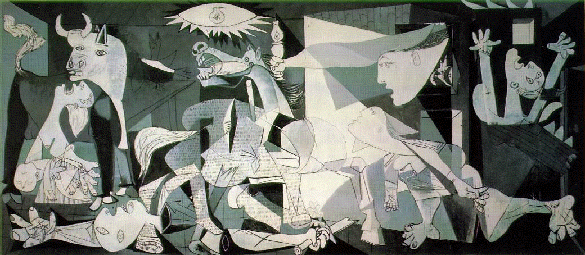 |
 Click on image to view large picture. |
 |
 Click on image to view large picture. |
|
At the end of the 2nd Republic, Nationalists led by Francisco Franco, took control of Spain. He bombed an innocent town, killing hundreds of people and damaging over 700 dwellings. This town was GUERNICA! You are a member of a team assigned to discover the secrets of Guernica. |
|
|
|
Your team is assigned the task of researching and presenting information on a specific topic concerning “GUERNICA ~ The event & the painting”
|
PROCESS
Decide as a team the
area of investigation you would like to tackle. Your choices are:
A. Background Information on Pablo Picasso (His early life, family history, personality, his start as an artist, etc.). Boring facts are not permitted! Picasso's life is full of interesting stuff.
C. Guernica the Event. A fire that lasted three days, destroyed 721 dwellings and was labeled a “terrible mistake” by the aggressors. Discover the secrets behind this tragic event during Spain's Civil War.
B. Picasso's Artistic Styles. Picasso was continually developing new ways of expressing himself. His styles included his Rose, Blue, Cubist, Surrealistic periods and more. Find out how Picasso developed as an artist and what people thought about his art and the artist.
D. Guernica the Painting. Picasso was living in France when he heard of the Guernica Tragedy. Guernica became the focal point of the Spanish pavilion at the Paris World's Fair in 1937. Discover the symbolism (hidden meanings) of this gigantic work of art. Be sure to include details about the creation of the painting. What did critics say? Where is it now and why? There is even said to be hidden images in Guernica. Can you find them?
E. Propaganda and Protest. Our modern times are filled with images of this nature. Ever since the 50s & 60s songs, art, literature and films that make a statement have become common place. What are some of the images (and the reasoning behind them) in our modern world?
Remember you are to present your discoveries to the world. Dig deep for details and interesting facts. Thoroughness is the key. Chose a visually interesting way to present your findings. For example a HyperStudio or Power Point presentation, a mobile or roll movie or even a illustrated book. BE CREATIVE!!
|
|
|
| http://www.emory.edu/PHILOSOPHY/ART/guernica.html |
Prof. Patterson's Guernica Home Page |
|
Propaganda Techniques |
|
|
Online Picasso Project |
|
|
Search word Picasso |
|
|
WebMuseum, Paris ~ Cubism |
|
|
Text only on the history of Guernica |
|
|
http://www.pbs.org/treasuresoftheworld/a_nav/guernica_nav/main_guerfrm.html |
PBS Treasures of the World - Guernica |
|
|
|
|
|
|
|
|
|
|
|
|
| ORGANIZATION |
|
|
|
|
| CREATIVITY |
|
|
|
|
| GROUP WORK |
|
|
|
|
| AUDIENCE RESPONSE |
|
|
|
|
|
|
|
|
|
|
GRADING SCALE
|
|
|
|
|
|
|
|
|
|
|
|
|
|
|
CONCLUSION
1. Who
was Picasso?
2. Why was he so famous?
3. What were his different styles?
4. What is Cubism?
5. Where did the name originate?
6. How did Guernica come to be painted?
7. What does it express?
8. Picasso was known to be “apolitical” what do you think that means?
9. Why do you think he was concerned enough about Guernica the event to create Guernica the painting?
10. How did Picasso's form of peaceful protest create such an impact on the world?
11. Is this form of protest worthwhile, better than protest with force?